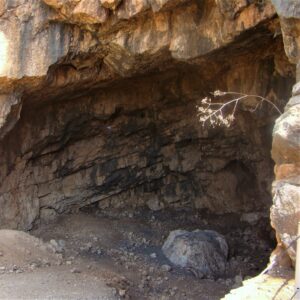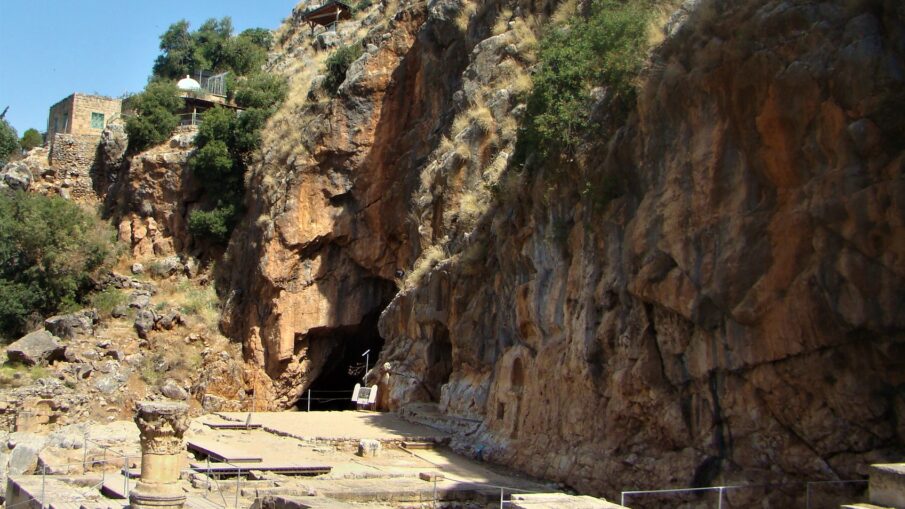From childhood, I dreamed of one day seeing Jerusalem, Bethlehem, Capernaum and the Sea of Galilee. Hermon Stream Nature Reserve never made my bucket list.
But if you visit Israel, it should be high on your itinerary lineup.
Our group stopped at Caesarea Philippi, at a place called The Banias. The headwaters of the Jordan River form here, and it was a pagan worship center at the time of Christ. Much focus was on the Greek god Pan (in fact the city was known as Panias). Water played a significant role in this worship, and the belief was that the network of underground water passages led directly to the underworld, home of the gods.
When water descended from nearby Mount Hermon each spring, the ancients believed it was a message from the gods. One particular cave entrance became their recognized open door to the underworld. One source says the city’s residents would engage in sexual rituals involving prostitutes and goats at this entrance, and that the goats later would be thrown down into a deep rock-walled cavern and eventually fall out into the water as live sacrifices to the gods. An earthquake later closed the bottom end of the cave, but the reshaped space remains today.
Hermon Stream Nature Reserve encompasses this ancient area and pagan ritual grounds. Caesarea Philippi is an archaeological treasure trove, where experts still dig for evidence of a city that once wielded great influence. Remnants of the temple honoring Pan have been excavated. As the name suggests, Hermon Stream also features some small waterfalls and creeks. In places, it resembles a typical American nature reserve.
But this place is far from typical.
Anyone who controlled Caesarea Philippi also controlled an ancient road that stretches from Africa to Iran. It had many names, but in biblical accounts, you will read of it as the Damascus Road, the place where Paul, tormentor of the early church, encountered a bright light and suffered temporary blindness before becoming a convert to Christianity (Acts 9:1-19). This point is about 40 miles as the crow flies from Damascus, and Acts only records that Paul’s encounter came “as he was approaching Damascus” (verse 3). As with many locations, it’s all but impossible to know the precise point of something from a biblical passage. Paul’s fateful spot likely was many miles from here. But for a first-time visitor to Israel, to glance upward and see the Damascus Road running along a hillside is memorable travel experience.
We entered the reserve area and The Banias with our Israeli guide, who began reading from the gospel of Matthew, chapter 16.
Verse 13 of Matthew 16 says “Now when Jesus came into the district of Caesarea Philippi…” The Bible is filled with geographic references. Other texts regarded as sacred in the Buddhist, Muslim and Hindu traditions make few references to location. Not true of the Old and New Testaments.
“When one takes a look at Scripture, one finds hundreds and hundreds of references to geographic reality,” says Barry J. Beitzel, a biblical scholar, author and cartographer. “The Bible’s use of the geographic dimension allows it to stand in radical opposition to other holy writings.”
Such references are of great benefit to travelers and biblical scholars alike.
Matthew 16 continues with the observation that Jesus had gathered his disciples around him in this setting, and questioned them.
“Who do you say that I am?” He asked. Peter replied, “you are the Christ, the son of the living God.”
Verse 18 of that chapter records familiar words from Jesus: “And I tell you that you are Peter, and on this rock I will build My church, and the gates of Hades will not prevail against it.”
By the time I arrived at The Banias, I had heard or read this account dozens of times for decades. Every single time I encountered it, my attention focused on Peter, The Rock. His faith was to be the firm foundation for the Christian church in Rome. I never paid much attention to the second part of that verse, which says the “gates of Hades will not prevail against it.”
This surprising travel find was about to change all of that.
Was Jesus simply waxing poetic there, creating mental imagery of the fearsome gates of Hell to further enhance his strong statement about Peter?

Our guide gestured just a few feet away, to that cavern opening where those ancient animal sacrifices were tossed. It’s common ancient name, he revealed, is the Gates of Hades.
So it’s possible Jesus and the disciples were standing in this very spot when he made his proclamation about Peter.
Again, scholars are not in total agreement about the specific geographical spot for this moment in Matthew. But when you’re a first-time traveler in Israel, early in your itinerary, an “Aha!” moment like this is unforgettable.
As the trip progressed, we would see several Jerusalem locations where scholars believe the Crucifixion might have transpired. We would visit a place known as the Garden Tomb, with rock-hewn sepulchers similar to where Jesus was laid. We stopped at the Church of the Nativity in Bethlehem, built in a spot where some believe the manger of Jesus’ birth was found.
A trip to Israel produces a lot of “maybe” moments, as in “maybe this was the spot, and maybe not.”
Hermon Stream Nature Reserve was my first such moment. I won’t forget it.

